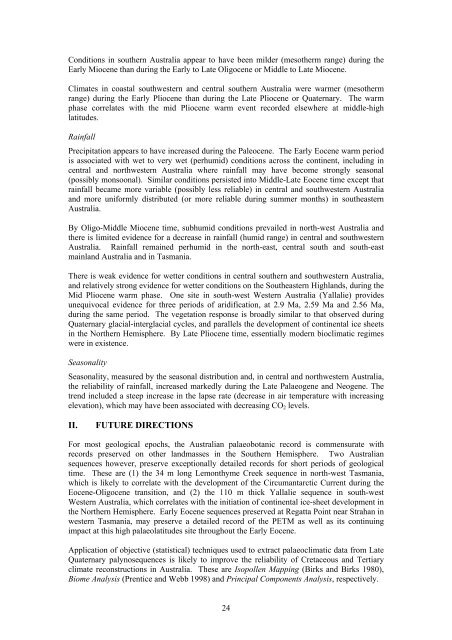OFR 151.pdf - CRC LEME
OFR 151.pdf - CRC LEME
OFR 151.pdf - CRC LEME
Create successful ePaper yourself
Turn your PDF publications into a flip-book with our unique Google optimized e-Paper software.
Conditions in southern Australia appear to have been milder (mesotherm range) during the<br />
Early Miocene than during the Early to Late Oligocene or Middle to Late Miocene.<br />
Climates in coastal southwestern and central southern Australia were warmer (mesotherm<br />
range) during the Early Pliocene than during the Late Pliocene or Quaternary. The warm<br />
phase correlates with the mid Pliocene warm event recorded elsewhere at middle-high<br />
latitudes.<br />
Rainfall<br />
Precipitation appears to have increased during the Paleocene. The Early Eocene warm period<br />
is associated with wet to very wet (perhumid) conditions across the continent, including in<br />
central and northwestern Australia where rainfall may have become strongly seasonal<br />
(possibly monsoonal). Similar conditions persisted into Middle-Late Eocene time except that<br />
rainfall became more variable (possibly less reliable) in central and southwestern Australia<br />
and more uniformly distributed (or more reliable during summer months) in southeastern<br />
Australia.<br />
By Oligo-Middle Miocene time, subhumid conditions prevailed in north-west Australia and<br />
there is limited evidence for a decrease in rainfall (humid range) in central and southwestern<br />
Australia. Rainfall remained perhumid in the north-east, central south and south-east<br />
mainland Australia and in Tasmania.<br />
There is weak evidence for wetter conditions in central southern and southwestern Australia,<br />
and relatively strong evidence for wetter conditions on the Southeastern Highlands, during the<br />
Mid Pliocene warm phase. One site in south-west Western Australia (Yallalie) provides<br />
unequivocal evidence for three periods of aridification, at 2.9 Ma, 2.59 Ma and 2.56 Ma,<br />
during the same period. The vegetation response is broadly similar to that observed during<br />
Quaternary glacial-interglacial cycles, and parallels the development of continental ice sheets<br />
in the Northern Hemisphere. By Late Pliocene time, essentially modern bioclimatic regimes<br />
were in existence.<br />
Seasonality<br />
Seasonality, measured by the seasonal distribution and, in central and northwestern Australia,<br />
the reliability of rainfall, increased markedly during the Late Palaeogene and Neogene. The<br />
trend included a steep increase in the lapse rate (decrease in air temperature with increasing<br />
elevation), which may have been associated with decreasing CO2 levels.<br />
II. FUTURE DIRECTIONS<br />
For most geological epochs, the Australian palaeobotanic record is commensurate with<br />
records preserved on other landmasses in the Southern Hemisphere. Two Australian<br />
sequences however, preserve exceptionally detailed records for short periods of geological<br />
time. These are (1) the 34 m long Lemonthyme Creek sequence in north-west Tasmania,<br />
which is likely to correlate with the development of the Circumantarctic Current during the<br />
Eocene-Oligocene transition, and (2) the 110 m thick Yallalie sequence in south-west<br />
Western Australia, which correlates with the initiation of continental ice-sheet development in<br />
the Northern Hemisphere. Early Eocene sequences preserved at Regatta Point near Strahan in<br />
western Tasmania, may preserve a detailed record of the PETM as well as its continuing<br />
impact at this high palaeolatitudes site throughout the Early Eocene.<br />
Application of objective (statistical) techniques used to extract palaeoclimatic data from Late<br />
Quaternary palynosequences is likely to improve the reliability of Cretaceous and Tertiary<br />
climate reconstructions in Australia. These are Isopollen Mapping (Birks and Birks 1980),<br />
Biome Analysis (Prentice and Webb 1998) and Principal Components Analysis, respectively.<br />
24

















